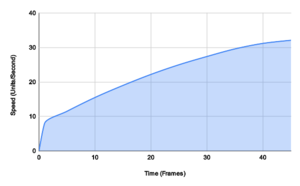Walking
Jump to navigation
Jump to search
| Walking | |
| Properties | |
| Hex | todo |
| Action Flags | todo |
| Action Group | Moving |
| ID | todo |
The walking action occurs when Mario is moving only by using the analog stick. It can also occur when exiting water (except if exiting water through a water jump). When walking[1]:
- mario_drop_held_object
- if should_begin_sliding; Begin Sliding
- if INPUT_FIRST_PERSON:
- mario_drop_held_object
- if actionState == 1; Standing Against Wall
- if forwardVel >= 16 and m->floor->normal.y >= 0.17364818; Braking
- else; Decelerating
- if INPUT_A_PRESSED; (todo; see ref) [2]
- if INPUT_B_PRESSED;
- if forwardVel >= 29 and stickMag > 48; yVel=20; Dive
- else; Move Punching
- if INPUT_UNKNOWN_5 (aka neutral joystick: https://ukikipedia.net/mediawiki/index.php?title=Turning_Around&oldid=17030); (same code as INPUT_FIRST_PERSON)
- if analog_stick_held_back and forwardVel >= 16; Turning Around
- if INPUT_Z_PRESSED; Crouch Slide
- update_walking_speed
- case GROUND_STEP_LEFT_GROUND; Freefall
- case GROUND_STEP_HIT_WALL; push_or_sidle_wall
Here's what update_walking_speed is for convenience:
void update_walking_speed(struct MarioState *m) {
f32 maxTargetSpeed;
f32 targetSpeed;
if (m->floor != NULL && m->floor->type == SURFACE_SLOW) {
maxTargetSpeed = 24.0f;
} else {
maxTargetSpeed = 32.0f;
}
targetSpeed = m->intendedMag < maxTargetSpeed ? m->intendedMag : maxTargetSpeed;
if (m->quicksandDepth > 10.0f) {
targetSpeed *= 6.25 / m->quicksandDepth;
}
if (m->forwardVel <= 0.0f) {
m->forwardVel += 1.1f;
} else if (m->forwardVel <= targetSpeed) {
m->forwardVel += 1.1f - m->forwardVel / 43.0f;
} else if (m->floor->normal.y >= 0.95f) {
m->forwardVel -= 1.0f;
}
if (m->forwardVel > 48.0f) {
m->forwardVel = 48.0f;
}
m->faceAngle[1] =
m->intendedYaw - approach_s32((s16)(m->intendedYaw - m->faceAngle[1]), 0, 0x800, 0x800);
apply_slope_accel(m);
}
/**
* Return the value 'current' after it tries to approach target, going up at
* most 'inc' and going down at most 'dec'.
*/
s32 approach_s32(s32 current, s32 target, s32 inc, s32 dec) {
//! If target is close to the max or min s32, then it's possible to overflow
// past it without stopping.
if (current < target) {
current += inc;
if (current > target) {
current = target;
}
} else {
current -= dec;
if (current < target) {
current = target;
}
}
return current;
}
void apply_slope_accel(struct MarioState *m) {
f32 slopeAccel;
struct Surface *floor = m->floor;
f32 steepness = sqrtf(floor->normal.x * floor->normal.x + floor->normal.z * floor->normal.z);
UNUSED f32 normalY = floor->normal.y;
s16 floorDYaw = m->floorAngle - m->faceAngle[1];
if (mario_floor_is_slope(m)) {
s16 slopeClass = 0;
if (m->action != ACT_SOFT_BACKWARD_GROUND_KB && m->action != ACT_SOFT_FORWARD_GROUND_KB) {
slopeClass = mario_get_floor_class(m);
}
switch (slopeClass) {
case SURFACE_CLASS_VERY_SLIPPERY:
slopeAccel = 5.3f;
break;
case SURFACE_CLASS_SLIPPERY:
slopeAccel = 2.7f;
break;
default:
slopeAccel = 1.7f;
break;
case SURFACE_CLASS_NOT_SLIPPERY:
slopeAccel = 0.0f;
break;
}
if (floorDYaw > -0x4000 && floorDYaw < 0x4000) {
m->forwardVel += slopeAccel * steepness;
} else {
m->forwardVel -= slopeAccel * steepness;
}
}
m->slideYaw = m->faceAngle[1];
m->slideVelX = m->forwardVel * sins(m->faceAngle[1]);
m->slideVelZ = m->forwardVel * coss(m->faceAngle[1]);
m->vel[0] = m->slideVelX;
m->vel[1] = 0.0f;
m->vel[2] = m->slideVelZ;
mario_update_moving_sand(m);
mario_update_windy_ground(m);
}
static s16 sMovingSandSpeeds[] = { 12, 8, 4, 0 };
u32 mario_update_moving_sand(struct MarioState *m) {
struct Surface *floor = m->floor;
s32 floorType = floor->type;
if (floorType == SURFACE_DEEP_MOVING_QUICKSAND || floorType == SURFACE_SHALLOW_MOVING_QUICKSAND
|| floorType == SURFACE_MOVING_QUICKSAND || floorType == SURFACE_INSTANT_MOVING_QUICKSAND) {
s16 pushAngle = floor->force << 8;
f32 pushSpeed = sMovingSandSpeeds[floor->force >> 8];
m->vel[0] += pushSpeed * sins(pushAngle);
m->vel[2] += pushSpeed * coss(pushAngle);
return TRUE;
}
return FALSE;
}
u32 mario_update_windy_ground(struct MarioState *m) {
struct Surface *floor = m->floor;
if (floor->type == SURFACE_HORIZONTAL_WIND) {
f32 pushSpeed;
s16 pushAngle = floor->force << 8;
if (m->action & ACT_FLAG_MOVING) {
s16 pushDYaw = m->faceAngle[1] - pushAngle;
pushSpeed = m->forwardVel > 0.0f ? -m->forwardVel * 0.5f : -8.0f;
if (pushDYaw > -0x4000 && pushDYaw < 0x4000) {
pushSpeed *= -1.0f;
}
pushSpeed *= coss(pushDYaw);
} else {
pushSpeed = 3.2f + (gGlobalTimer % 4);
}
m->vel[0] += pushSpeed * sins(pushAngle);
m->vel[2] += pushSpeed * coss(pushAngle);
#ifdef VERSION_JP
play_sound(SOUND_ENV_WIND2, m->marioObj->header.gfx.cameraToObject);
#endif
return TRUE;
}
return FALSE;
}
